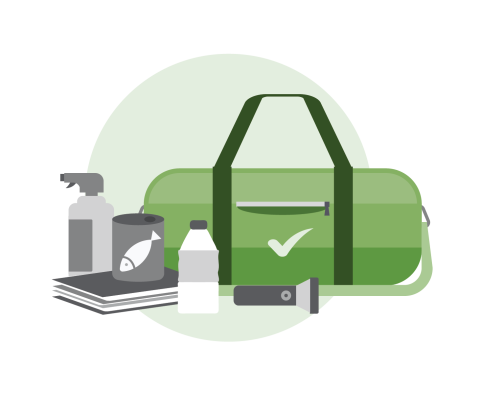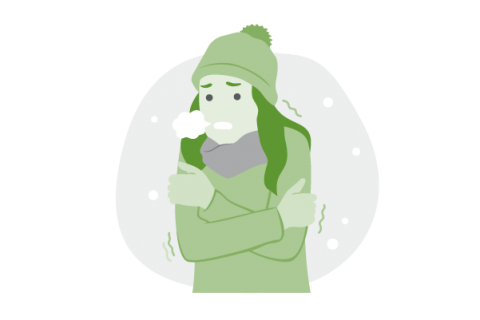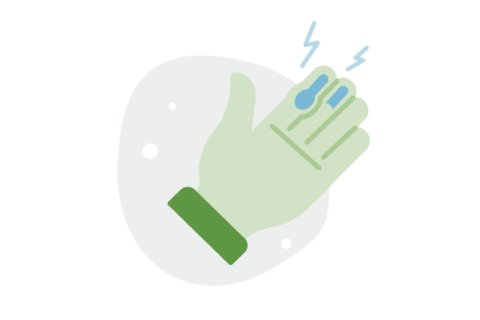Words to Know
Am I at Risk?
What Can I Do?
Learn More
During winter, the air outside can get very cold. A winter storm happens when there is heavy rain and the temperature is low enough that the rain turns to ice or forms as sleet or snow. Winter storms can be freezing rain and ice, moderate snowfall over a few hours, or a blizzard that lasts for several days.
Sometimes, winter storms bring strong winds, ice, sleet, and freezing rain. Winter weather can knock out heat, power, and communications. Sometimes, this can last for days or weeks. Icy roads can also cause serious accidents.
Many winter storms bring dangerously low temperatures. Sometimes, people are injured or die from being in really cold temperatures for too long because this can lead to hypothermia or frostbite.
Words to Know
Freezing Rain - Rain that freezes when it hits the ground. This makes a layer of ice on roads, walkways, trees, and power lines.
Hypothermia - A sickness when your body temperature drops below what is needed to be healthy and work properly.
Winter Weather - A warning issued when conditions could cause dangerous situations (such as icy roads or sidewalks).
Frostbite - A medical condition when skin or body tissue is damaged from freezing.
Sleet - Rain that turns to ice before reaching the ground.
Winter Storm Watch - A warning issued when severe winter conditions may affect your area.
Winter Storm Warning - A warning issued when a lot of snow or sleet is expected in the next few hours or day.
Am I at Risk?
Almost everyone in the United States can be affected by winter storms and extreme cold.
What Can I Do?
Before

- Build an emergency kit to last for several days or weeks in case you must stay at home.
- Make a family communications plan.
- Help your parents sprinkle rock salt, sand or kitty litter on sidewalks and walkways. This helps to make them less slippery.
- Make sure you dress warmly and have extra blankets!
- Bring pets inside. They can be injured by the cold, too.
During
- Stay inside!
- Sidewalks can be very slippery, and you can hurt yourself if you fall.
- If you are outside helping to shovel snow, make sure you wear a hat. It helps keep you from losing body heat. Cover all exposed parts of your body. Wear layered clothing and wear a hat and a scarf, cover your mouth to protect your face and keep you warm.
- Wear mittens, if you have them. They’re warmer than gloves.
- Put on dry clothes as soon as you come inside.
- If you can’t feel your fingers, toes, ears, or nose, or they appear white or grayish-yellow, tell a grown-up immediately. Frostbite is dangerous and you may need to see a doctor.
- Tell a grown up immediately if you can’t stop shivering, have trouble remembering things, feel tired or talk funny. You may have hypothermia, which can be very dangerous.
- If your family uses a generator, make sure to use it outside. Keep it away from the house to avoid carbon monoxide poisoning.
- If your home loses power, you and your family can go to a designated public shelter or warming center.
After
- Continue to wear layers, a hat, scarf, and mittens or gloves. These will help to keep you warm and protect you from frostbite and hypothermia.
- Remind your parents to clean surfaces that people touch frequently, like doorknobs, light switches, and remote controls.
Learn More
Did you know?

Hypothermia is an unusually low body temperature. Signs can be shivering, exhaustion, confusion, fumbling hands, memory loss, slurred speech, or drowsiness. If you see signs of hypothermia in someone, get them to a warm room. Warm the center of the body first, such as the head, neck, and chest. Keep them dry and wrapped up in warm blankets, including the head and neck.

Frostbite causes a loss of feeling and color in the face, fingers, or toes. Frostbite can make skin numb and change color to white or grayish-yellow. Skin can also become firm or waxy. If you see signs of frostbite, go to a warm room. Soak in warm water. Do not massage or use a heating pad.


